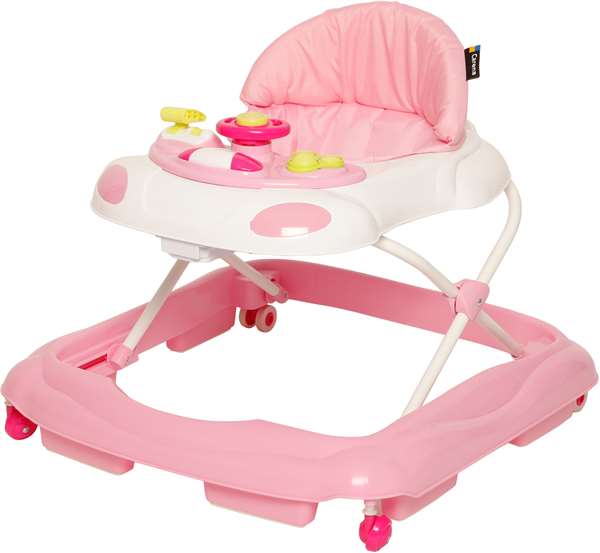Walkers can be used for short periods on a few occasions but do not teach the child to develop. If used extensively, the walker is purely negative for the child’s development – both for motor skills and also for cognitive development. There is also a risk of accidents, which in some cases can lead to serious head and neck injuries.
In the walker, the child does not need to pay attention to its motor skills because there are no consequences of, for example, leaning the head or having a slanted body posture – the child does not fall. The child does not need to struggle and problem-solve to move forward under its own power. The lack of tasks to solve to control the body leads to the child becoming inattentive. Some children who have spent a lot of time in walkers have difficulty bearing weight on their legs when walking normally, and some walk with their heads tilted to one side. If the head tilt persists, the child may have programmed in “wrong” goal to strive for. During the first year, it is important for the child to learn that the goal of balance is to have a straight back and eyes on the horizontal plane, not to have the neck tilted and one eye higher than the other.
A new problem is that children spend many hours in walkers and do not lie on their tummys. This can sometimes lead to the child having poorer hand function because the hand needs to weightbear and push against the floor to increase wrist mobility. As a newborn, the hand is clenched – when the child crawls, the wrist bends backward while the fingers stretch, and the child increases its mobility and strength. Weight-bearing is important for the proprioceptive sense, that we feel the hand’s movements. Mobility is important for us to have a strong grip with a backward-bent wrist.
Children who have spent a lot of time in walkers and do not want to lie on their tummys often lie with fisted hands. If so, you need to play, train, and motivate the child to become stronger. When the child starts walking, it is not as natural to develop the foundation for good sensation and a strong grip in the hands.
Research shows that walkers delay both motor and intellectual development and can cause accidents. In Canada, walkers have long been banned; you can both end up in prison and face hefty fines if you sell or import a walker.
Läs ett utdrag från en av LTMs Facebook-inlägg här för att lära dig mer om varför:
Crawling is an incredible task that affects so many other things. Including muscle strength in the shoulders, arms, and hands. I was so happy at work the other day when my 3-year-old friend (with special challenges) learned to crawl. He could explore, disappear in a different direction than mom, choose who he wanted to go to, and play peek-a-boo behind furniture. Crawling is more tiring than walking – just try crawling for a few hours (most likely beneficial for anyone who texts on the phone most of the day – stretching the hand muscles)!
This got me thinking about what I recently learned, that in Canada, baby walkers are banned. If you sell a baby walker, you can be fined up to $100,000 or get 6 months in prison! Why? 3 reasons: 1. Accidents, 2. Delayed and impaired motor development 3. Even more impaired than motor development is mental development. There is research about this. How can this be? Well, consider this: If a baby lies on its stomach and starts reaching out an arm to grab a toy, she can have new sensory experiences when she tastes the toy, feels the texture with her hands, or hears the sound and feels the weight when she bangs the toy on the floor. These experiences lead to curiosity and pushing boundaries to try to reach a little further, maybe starting to move sideways in a circle to find something new to explore, and get new sensory experiences and new learning – she might find a piece of paper that has so many other qualities than the toy. This leads to even more curiosity, and the baby pushes itself to be able to move forward, crawl, get under the chair – learn the meaning of the word ‘under’. The baby continuously engages in problem-solving, finding strategies, relating the body to the environment, how she can reach what she wants and learn new things. Motor skills lead to sensory experiences (perception) which lead to learning (cognition). In the baby walker, the baby ‘flies’ forward, doesn’t need to bear its own body weight, he sits and pushes a little with his feet. He doesn’t even need to keep his head straight with his eyes on the horizontal plane because he doesn’t fall even if he leans. If a toy is on the table in front of him and it falls down, the baby doesn’t see the toy and can’t pick it up, but continues to move forward. There is no problem-solving and no learning about how to relate the body to the environment. The baby doesn’t need to PAY ATTENTION in the same way as the crawler, and the baby doesn’t fall when trying to do things at the edge of what she can handle, and learn from mistakes and find ways to do it better next time. All this is something I take for granted, but the fact that there is research and laws in Canada that understand this is incredible! Sweden is far behind. Here, children also sit in so-called ‘ergonomic’ strollers – they should be banned! More on this later!
